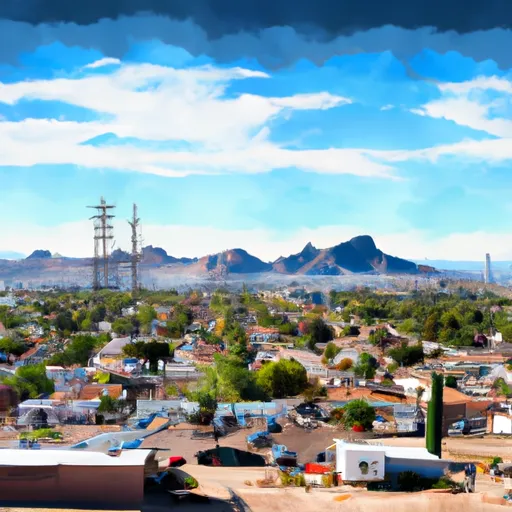-
 Snoflo Premium
Snoflo Premium
Get unlimited access to all our content
With no Ad interruptions! - Start Your Free Trial Login with existing account
Quartzsite
Eden Index
Climate
7.1
•
Recreation
2.4
•
Community
0.8
•
Safeguard
3.9/10

Quartzsite, Arizona is a small town located in the southwestern part of the state. It has a desert climate, characterized by hot summers and mild winters. Summers in Quartzsite can be scorching, with temperatures reaching over 100 degrees Fahrenheit, while winters are generally mild, with temperatures averaging around 60 degrees Fahrenheit. The town receives minimal rainfall, with most precipitation occurring during the winter months.
Hydrologically, Quartzsite is part of the Lower Colorado River basin, with the Colorado River being a significant water source. The town's water supply primarily comes from wells that tap into underground aquifers.
Quartzsite offers a variety of outdoor recreation opportunities due to its desert surroundings. Visitors can explore the nearby Kofa National Wildlife Refuge, known for its diverse wildlife and scenic landscapes. The region is also popular for rockhounding, with agates, jaspers, and quartz crystals being commonly found. Outdoor enthusiasts can engage in activities like hiking, off-roading, camping, and bird watching. The town also hosts numerous events, including gem and mineral shows, flea markets, and RV rallies, attracting visitors from all over.
What is the Eden Index?
The Snoflo Eden Index serves as a comprehensive rating system for regions, evaluating their desirability through a holistic assessment of climate health, outdoor recreation opportunities, and natural disaster risk, acknowledging the profound impact of these factors on livability and well-being.
Climate Health Indicator (CHI): 7.1
Quartzsite receives approximately
113mm of rain per year,
with humidity levels near 47%
and air temperatures averaging around
23°C.
Quartzsite has a plant hardyness factor of
9, meaning
plants and agriculture in this region tend to thrive here all year round.
By considering the ideal temperature range, reliable water supplies, clean air, and stable seasonal rain or snowpacks, the Climate Health Indicator (CHI) underscores the significance of a healthy climate as the foundation for quality living.
A healthy climate is paramount for ensuring a high quality of life and livability in a region, fostering both physical well-being and environmental harmony. This can be characterized by ideal temperatures, reliable access to water supplies, clean air, and consistent seasonal rain or snowpacks.
Weather Forecast
Streamflow Conditions
Lower Colorado
Area Rivers
Lower Colorado
Snowpack Depths
Lower Colorado
Reservoir Storage Capacity
Lower Colorado
Groundwater Levels
Recreational Opportunity Index (ROI): 2.4
The Recreational Opportunity Index (ROI) recognizes the value of outdoor recreational options, such as parks, hiking trails, camping sites, and fishing spots, while acknowledging that climate plays a pivotal role in ensuring the comfort and consistency of these experiences.
Access to outdoor recreational opportunities, encompassing activities such as parks, hiking, camping, and fishing, is crucial for overall well-being, and the climate plays a pivotal role in enabling and enhancing these experiences, ensuring that individuals can engage in nature-based activities comfortably and consistently.
Camping Areas
| Campground | Campsites | Reservations | Toilets | Showers | Elevation |
|---|---|---|---|---|---|
| Quartzite - La Posa | 1000 | 885 ft | |||
| Dome Rock Rd Dispersed | None | 1,147 ft | |||
| Bouse Community Park | 25 | 961 ft |
Nearby Ski Areas
Catastrophe Safeguard Index (CSI):
The Catastrophe Safeguard Index (CSI) recognizes that natural disaster risk, encompassing floods, fires, hurricanes, and tornadoes, can drastically affect safety and the overall appeal of an area.
The level of natural disaster risk in a region significantly affects safety and the overall livability, with climate change amplifying these risks by potentially increasing the frequency and intensity of events like floods, fires, hurricanes, and tornadoes, thereby posing substantial challenges to community resilience and well-being.
Community Resilience Indicator (CRI): 0.8
The Community Resilience Indicator (CRI) recognizes that education, healthcare, and socioeconomics are crucial to the well-being of a region. The CRI acknowledges the profound impact of these elements on residents' overall quality of life. By evaluating educational resources, healthcare accessibility, and economic inclusivity, the index captures the essential aspects that contribute to a thriving community, fostering resident satisfaction, equity, and social cohesion.

